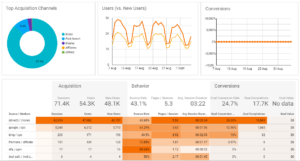In March 2020, the world changed.
And while some saw the beginning of the pandemic as the beginning of the apocalypse, others saw it as an opportunity to change their way of doing things.
Change the way they shop, how they do research, and how they spend their downtime.
And that makes sense, right?
The rise of remote working has enabled more people to surf the internet and do their business online than ever before. Social isolation has also motivated many to improve their immediate surroundings by ordering products and homeware online.
But that presents a challenge to business owners and webmasters.
- Are those customers finding what they’re searching for?
- Do they enjoy their browsing experience?
- Are they likely to return to or recommend your website to others when their session ends?
Businesses need to analyze customer engagement and see if they can answer Yes! to these questions.
Customer Engagement Analytics
Customer engagement refers to the way that customers interact with a business.
And tracking customer engagement in physical stores is relatively straightforward.
You can set up structures that allow people to respond favorably when interacting with your brand.
The right decor + Manage the air temperature inside the store + Service with a smile = Happy, returning customer.
 Source Pexels.com
Source Pexels.comYou can see how your customers respond to your product and their overall experience. This, in turn, tells you what you’re doing right and what you’re doing wrong.
Tracking customer engagement for an online business might be less straightforward, but it is doable.
Related article – Top Ecommerce Metrics to track in 2022
Customer Engagement Analytics allows businesses to put themselves in their customers’ shoes and think like the person visiting their website.
Doing this allows them to envision the customer journey from beginning to end and adjust their product accordingly.
Let’s look at 5 of the most important Customer Engagement metrics to track and why they’re essential to the longevity of your online business.
- The Net Promoter Score
The Net Promoter Score or NPS has to do with long-term customer loyalty and the likelihood of those individuals returning to purchase your product or view your web pages again.
An NPS is usually calculated using a single-question survey at various intervals during a customer journey. This gauges their satisfaction with your product or service.
“On a scale of 1 – 10, how likely are you to recommend [Company name] to others?”
That’s a typical example of a question you might have come across from which an NPS is calculated.
 Source Pexels.com
Source Pexels.comA score between 1 and 6 is regarded as negative, while scoring 7 or 8 is neutral.
In a net promoter score, you want your customer feedback to be either a 9 or a 10. This is considered a positive and the likelihood that the person will return or promote your brand to others is high.
Why is this important?
The higher the score, the more likely a company is to retain customers in the long run.
With the NPS, a company can make adjustments to improve the customer experience and monitor loyalty trends. This helps with your customer’s lifetime value.
A net promoter score also helps a business gauge how far ahead or behind they are in connection with their competition’s ability to retain customers.
- Customer Satisfaction Score
The customer satisfaction score, similar to the net promoter score, is calculated using a survey during the customer journey.
“On a scale of 1 – 10, how satisfied are you with your purchase.”
But the key difference between these two scores is that the CTS gives you insights into the short-term satisfaction of your clients. In other words, are they satisfied with their product purchase or website experience?
The scoring system is also formulated the same as the net promoter score. So you’re always aiming for your feedback to be either a 9 or a 10.
The higher the score, the higher your probability of customer retention.
Why is this important?
Knowing how satisfied your customers are on a short-term basis helps you to make real-time decisions.
For example, you can change how your checkout process works or pay more attention to the quality of your product to retain more customers if you notice a low score.
The customer satisfaction score also tells us a lot about customer behavior. That’s because we understand the likes or dislikes of website visitors with customer analytics.
Knowing how satisfied people are with your brand will help you engage them more effectively.
- Customer Effort Score
The third survey on our list is the customer effort score.
This score indicates the effort customers put into interacting with your company. It helps you understand some important factors that might need attention.
- Is it easy to find your website?
- Are your web pages easy to navigate?
- Do the ads and pop-ups take away from the customer experience?
- Is the checkout process easy enough to encourage clients to follow through with their purchases?
The reason why so many people choose to do their business online is that it makes life easier.
But the questions businesses need to ask are not only about the customer’s experience but also about the effort they put into making life easier for customers.
- How much effort are we putting into solving issues for our customers?
- How much time do we dedicate to helping our customers make successful purchases?
- Are we investing our time and money wisely to create a user-friendly experience?
Knowing the answers to these questions will help you make the shopping experience enjoyable for your customers and improve customer engagement.
Why is this important?
Suppose the layout of your website or factors like advertising pop-ups and forms take away from that experience. In that case, your customers will likely not have the patience to remain on your pages all the way to a successful checkout.
 Source Pexels
Source Pexels- Churn
The churn rate is the number of customers that stop interacting with your business or website during a given period.
It’s essential to know your business churn rate because this helps you plan for the long-term stability of your business.
For example, each year, airlines offer flight specials at more or less the same time. Have you ever thought about why?
Well, if a destination has fewer visitors each year during a specific season due to unpleasant weather conditions, the airlines need to coax passengers to still fly on that route.
So each year, airlines will drop their airfare to that destination for a few months and advertise these specials on social media platforms and the internet.
By doing this, airlines stabilize their businesses and avoid a near shutdown during these lows in their business.
Why is this important?
Understanding your business’s churn rate helps you do the same thing – plan for those difficult times each year.
You can put more effort into advertising or adjust your prices accordingly, thus improving customer engagement during these difficult months.
- Social Media
The importance of social media analytics cannot be understated.
Not only are people browsing pictures of their favorite products, but they are also sharing them with all their followers. All businesses, great and small, need a solid social media presence.
 Source Pexels.com
Source Pexels.com
Why is this important?
Knowing which of your products are most liked and shared on social media can give you the competitive edge your business needs to succeed.
You’ll know what people are most interested in and thus plan your marketing initiatives accordingly.
You need to engage with customers regularly through multiple channels to make your brand known to potential customers.
Using this Data
With this aggregate data, you can identify overlapping user behavior and needs. This, in turn, allows businesses to create customer segments for their audience and place groups of people (virtually) into these different segments.
What is Customer Segmentation?
Customer Segmentation is placing customers into specific categories based on shared traits. This makes it easier for businesses to manage their communication with particular customers.
Different segments could include
- Demographic Segmentation
- Geographic Segmentation
- Behavioral Segmentation
- Needs-based Segmentation
- Value-based Segmentation
It goes without saying that customers that fall into the same segment will likely have the same queries, issues, and interests.
Why is this important?
Placing customers in and understanding the needs of each segment of customers is what helps businesses plan their communication channels and loyalty programs accordingly.
Tracking customer engagement analytics
Many web analytics tools enable businesses to set their KPIs and track their customer engagement metrics.
The best-known one is probably Google Analytics.
With their free platform, you can view multiple metrics in one dashboard.
 Google Analytics demo
Google Analytics demoOne of the biggest challenges with GA is that its ability to draw data from many sources and compile them into one dashboard can be overwhelming.
Having all the information in the world doesn’t help if it’s difficult to dissect data reports.
Abralytics is a Google analytics alternative that caters to start-ups and small and medium-sized businesses.
The Customer Engagement metrics spoken of earlier are all tracked with abralytics, but the way it presents this information is where it really shines.

Abralytics Demo
A simple yet powerful dashboard that only shows you the customer data you need. This helps you focus your energy on the customer engagement strategies that suit your business needs.
Try Abralytics for hassle-free data analytics today.




